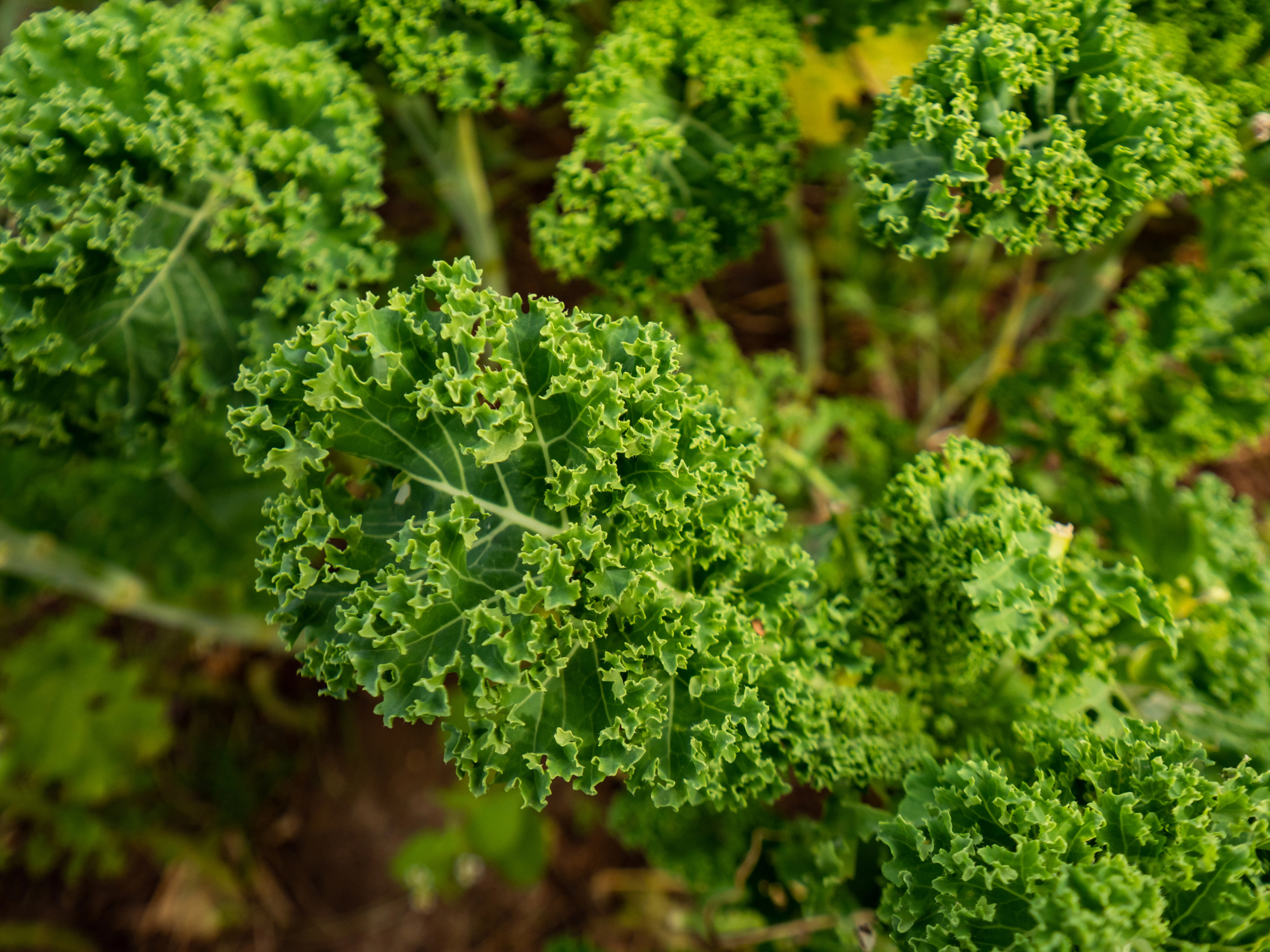Kale Donation Tracker
Quick Links: How & Where to Grow | Temperature | How to Care For | Harvest Signs | Harvesting | Pruning | Pests | Companions | Varieties | Preservation | Recipes | Michigan Tips | Overwintering | Fun Facts
🌱 How & Where to Grow Kale:
- Start March-April or direct seed.
- Fall planting August-September – frost makes it incredibly sweet!
- Space plants 12-18 inches apart in rows 18-24 inches apart.
- Sunlight: Full sun to partial shade (4-6 hours minimum).
- Soil Type: Well-drained soil with pH 6.0-7.5.
- Soil Amendment: Moderate fertility needed – too rich causes pest problems
Kale is the ultimate hardy hero – it laughs at frost and gets sweeter with cold!
🌡️ Temperature Guidance:
Best 60-65°F. Tolerates 20°F bare, -10°F covered. Sweetens after frost.
- Optimal growth: 60-70°F, but very adaptable.
- Cold hardiness: Survives 20°F uncovered, -10°F with protection.
- Frost exposure converts starches to sugars.
- Heat above 80°F makes leaves bitter and tough.
Michigan winters are kale’s playground – it’s often the last thing standing in the garden!
💧 How to Care for:
- Consistent Moisture: Maintains tender leaves.
- Watering: 1-1.5 inches weekly for steady growth.
- Mulch: 2-3 inches to retain moisture and suppress weeds.
- Fertilizer: Light feeding monthly – too much attracts aphids.
- Support: Tall varieties may need staking in winter.
📏 Harvest Signs:
Baby: 4-5 weeks. Mature: 7-8 weeks. Pick outer leaves first.
- Kale is a cut-and-come-again crop – harvest regularly!
- Baby kale ready when leaves are palm-sized.
- Mature leaves can be as large as your hand.
- Always leave center growing point intact.
The more you harvest, the more it produces – don’t be shy!
🧺 Harvesting:
Pick from bottom up. Leave 4-5 center leaves. Morning harvest best.
- Always harvest oldest leaves first from bottom.
- Use scissors or knife for clean cuts.
- Never strip plant bare – leave growing center.
- Morning harvest when leaves are crisp.
- Wash immediately if aphids are present.
✂️ Pruning:
Remove yellowing leaves. Top for bushier growth. Spring cleanup for overwintered plants.
- Remove yellow or damaged lower leaves regularly.
- Top tall plants to encourage bushier growth.
- Spring pruning: Cut overwintered plants to 4 inches for regrowth.
- Flower stalks: Remove unless saving seeds.
- Summer trim: Cut back leggy plants by half.
🪲 Michigan Pests:
Cabbage worms, aphids on curled varieties, flea beetles.
- Cabbage worms – less problematic than on cabbage. Bt if needed.
- Aphids – gray aphids love curly varieties. Blast off.
- Flea beetles – tiny holes in spring. Row covers help.
- Largely pest-free compared to other brassicas!
🫱🏽🫲🏼 Companions:
Onions, garlic, herbs, marigolds, beans. Compatible with brassicas.
- Onions and garlic repel many pests.
- Herbs like dill and cilantro attract beneficials.
- Beans fix nitrogen for leafy growth.
- Beets and chard make good neighbors.
- Can grow with other brassicas unlike some.
🥬 Varieties:
Cold-hardy: ‘Winterbor’, ‘Red Russian’. Summer: ‘Lacinato’.
- ‘Winterbor’: 60 days, extremely cold hardy, frilly blue-green.
- ‘Red Russian’: 60 days, purple stems, oak-leaf shape, very hardy.
- ‘Lacinato’ (Dinosaur): 62 days, heat tolerant, bumpy leaves.
- ‘Siberian’: 60 days, extremely cold hardy, tender leaves.
- ‘Redbor’: 55 days, deep purple, ornamental and edible.
🫙 Preservation:
Freeze blanched 2½ minutes. Dehydrate for chips. Ferment.
- Freezing: Blanch 2.5 minutes, freeze in portions.
- Kale chips: Dehydrate seasoned leaves until crispy.
- Fresh storage: 1-2 weeks in crisper drawer.
- Fermented: Make kale kraut like sauerkraut.
- Smoothie packs: Pre-portion and freeze for smoothies.
- Pesto: Freeze kale pesto in ice cube trays.
🧑🏽🍳 Recipes:
Massaged salad with apples, white bean soup, kale chips.
- Massaged kale salad – massage with oil to tenderize.
- Tuscan white bean and kale soup.
- Kale chips with nutritional yeast.
- Green smoothies with frozen kale.
- Sautéed kale with garlic and lemon.
✋🏼 Michigan Tips:
- Grows year-round with protection.
- Fall planted kale sweetest.
- Survives winter in cold frames.
- Spring kale provides early greens.
- Michigan’s snow acts as natural insulation.
- Plant every 3 weeks for continuous harvest.
❄️ Overwintering:
- Most cold-hardy vegetable you can grow!
- Survives uncovered to 20°F, covered to -10°F.
- Use row covers or cold frames for protection.
- Mulch heavily around plants before ground freezes.
- Harvest all winter on mild days.
- Plants will resume growth in early spring.
🧠 Fun Facts:
- Grown in Antarctica.
- More vitamin C than oranges.
- “Kail” = kitchen garden in Scotland.
- Kale was the most common green vegetable in Europe until the Renaissance.
- One cup has more calcium than a cup of milk.
- Purple kale turns green when cooked.
- Ornamental kale and edible kale are the same species.
- Kale can survive and produce for 2-3 years in mild climates!


0 Comments